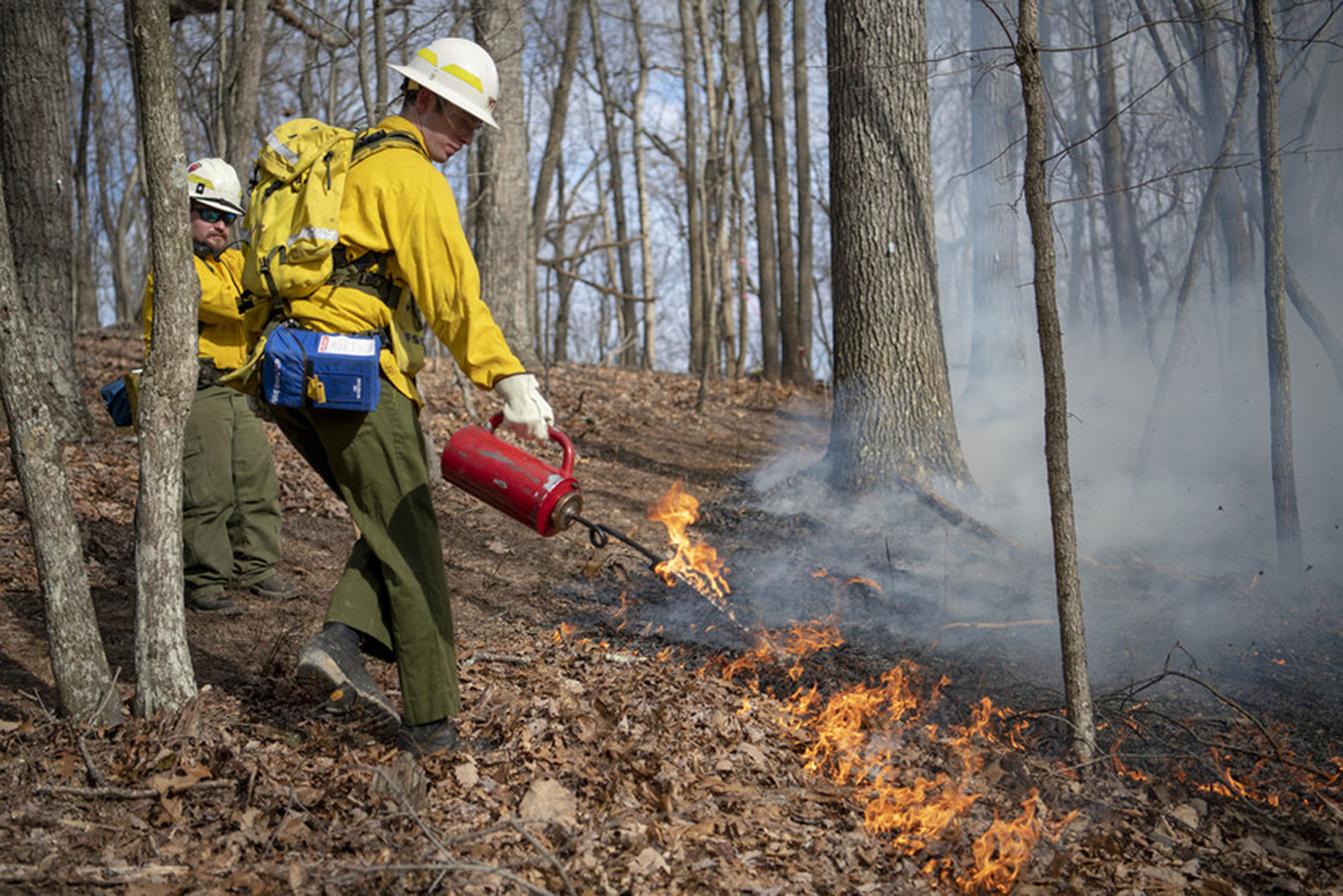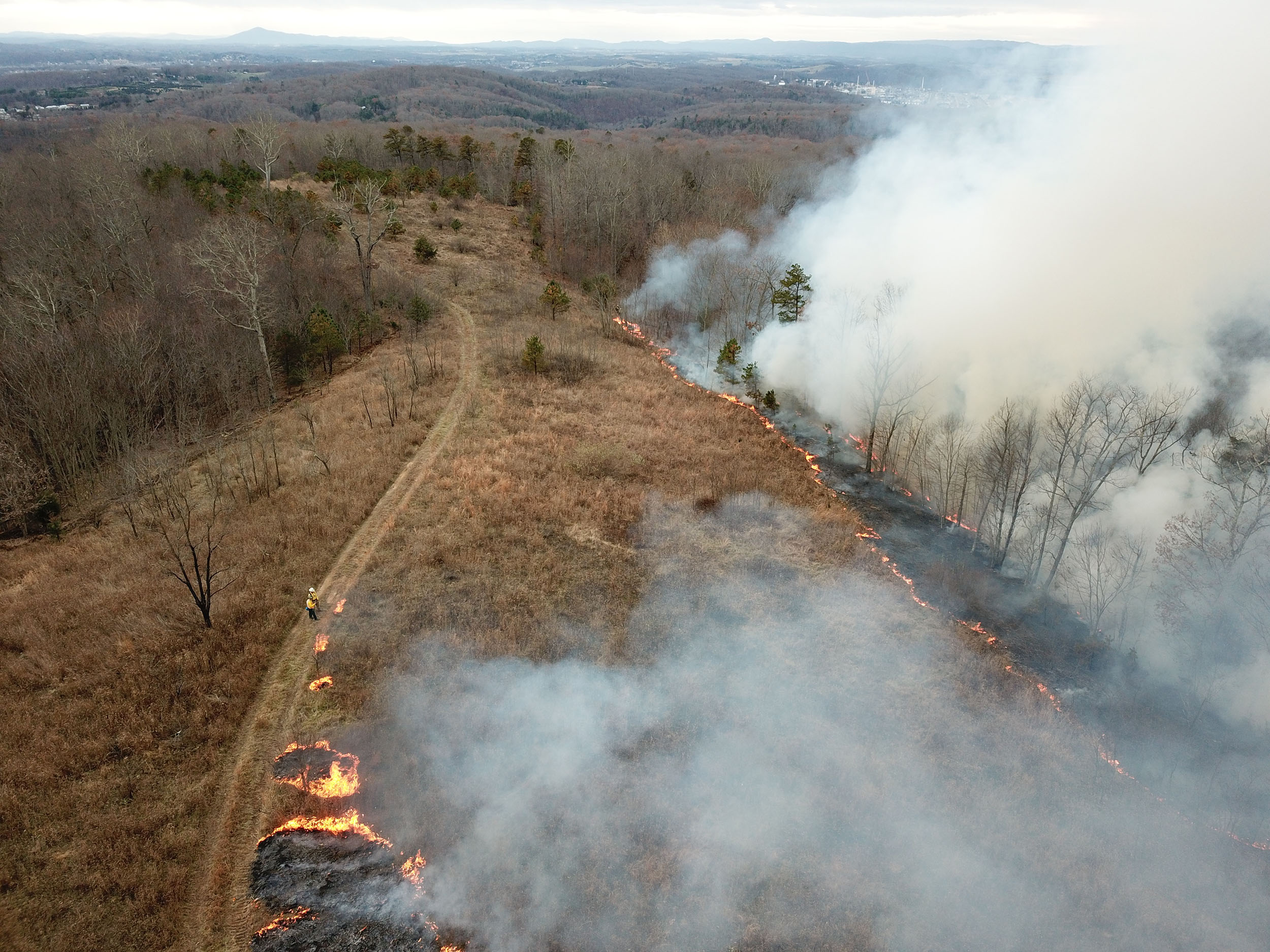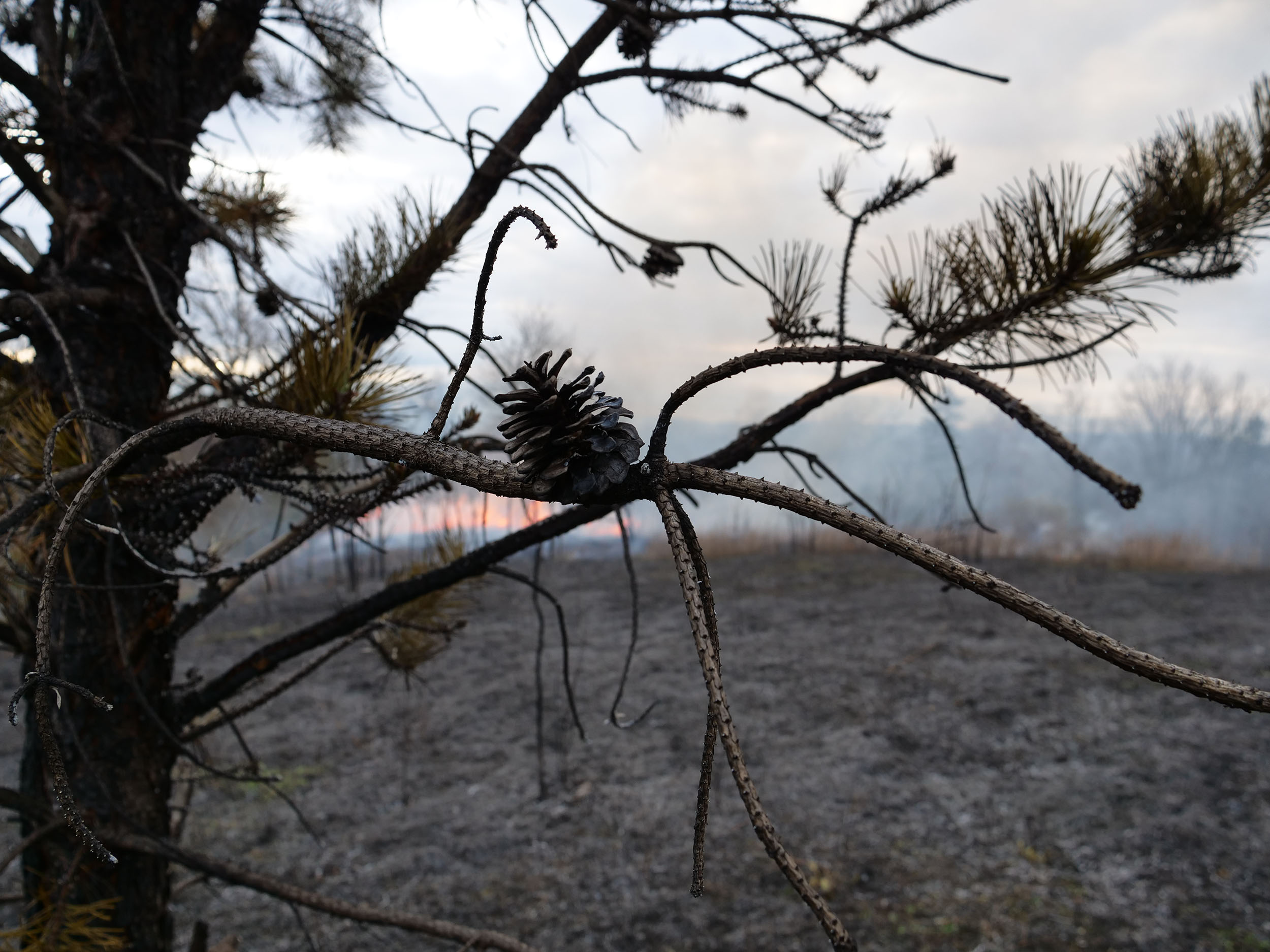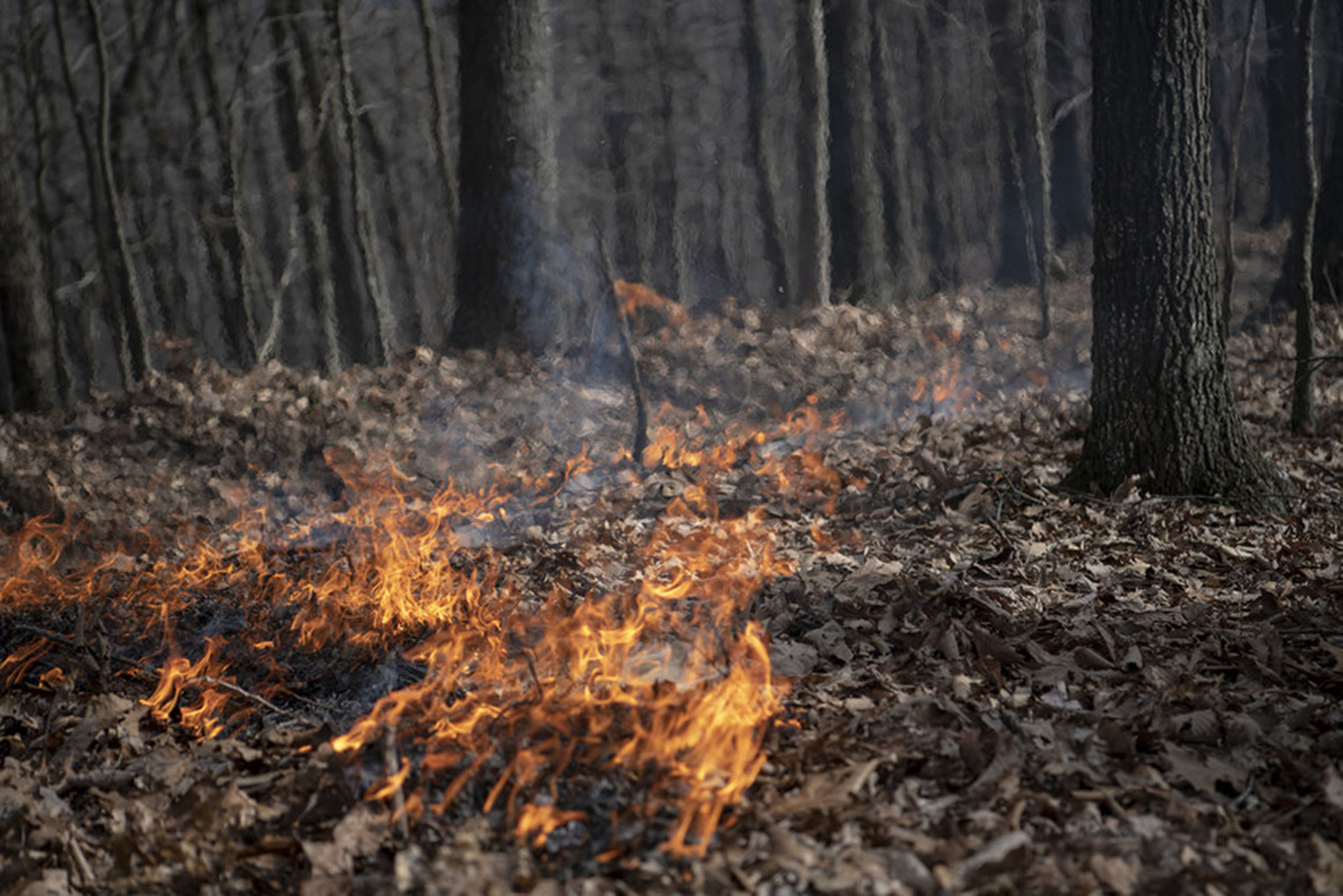by David Fleming
Molly Hunt tilts a drip torch. Inside the canister, a liquid mixture of gasoline and diesel fuel shifts forward and siphons down, making a full circle around the fuel trap loop before reaching the lit wick. Hunt, a forestry major in the College of Natural Resources and Environment, begins to pour fire.
On the other side of the ridge, senior forestry major Emily Newcombe lights a parallel line. The radio on Newcombe’s shoulder chirps as voices direct her movements. At the perimeter of the burn, students and members of the Virginia Department of Forestry stand guard, ready to prevent any wayward sparks from crossing the fire line.
The fire starts small. As the flames grow, they burn branches and singe the lower bark of trees. Eventually flames climb 10, then 20 feet high.
This is a work day for students in Virginia Tech’s Wildland Fire: Ecology and Management course. Today’s assignment: a prescribed burn.

Using a leaf blower to prepare a fire break
A History of Fire
Fire has always played a role in the forest ecology of southwestern Virginia.
“If you look back on the history of our forests, fire has been a natural part of a forest’s life,” said Adam Coates, assistant professor of forest fire ecology and management in the Department of Forest Resources and Environmental Conservation. “Wildfires may have ignited when a lightning strike occurred during drier conditions. The fire would move and meander until precipitation extinguished it, a stream or water body created a boundary to contain it, or it ran into fuels that would not ignite. We also know that Native Americans used fire to clear land for agriculture or to maintain wildlife habitat.
“Many older trees have been harvested to expose their annual growth rings,” he continued. “Often, you can see in the rings when fire events happened, and you can tell that some of the fire events were occurring when the trees were dormant during cold months, when forest fires from lightning strikes would be unlikely to occur. So we’re in an area that was once dominated by repeated and frequent fires, both naturally occurring and man-made.”
The rise of development, and particularly the movement toward urban living over the past century, has led to efforts designed to prevent naturally occurring fires in order to protect people and property.
“As a result, we have forests in Virginia that have large accumulations of fuel in places where a long time ago fire would have burned off that excess,” Coates said. “Controlled burns allow us to return the forests to a balance that once occurred naturally, while making sure that wildfire can’t reach where people live.”
The forests of Appalachia, less studied than drier landscapes where wildfire is a more prevalent occurrence, present compelling new areas of research related to fire use and prevention.
“We’ve gone so long without fire being prevalent on the landscape that it’s really hard to put fire back and expect it to do what we think it did a long time ago,” Coates said. “To some degree, we have novel forests now. We took fire away and in doing that we’ve changed the dynamics of our forests. So trying to put it back is a complicated and challenging process. But it’s also pretty interesting.”
For Molly Hunt, working in forestry has always been an ambition.
“I grew up in the woods,” said Hunt, a May 2019 graduate. “I have a huge passion for conserving the land and protecting the woods, and I came to Virginia Tech wanting to learn how to do that.”
The wildland fire course inspired Hunt to join the New River Valley Wildland Fire Crew. Monthly training activities sponsored by the group helped her work toward an Incident Qualification Card, a requirement for fire crews working on federal lands.

Prescribed burn ignition using a drip torch
Preparing to Light
Prescribed fires are not appropriate for every portion of our current landscapes. Some areas have gone extended periods without fire, and other management activities might be needed before prescribed fire can be considered as an option. Careful consideration and planning are necessary for prescribed fire, long before anyone can ignite fuel on the landscape.
On the day of the burn, the first stage of prescribed fire implementation on the ground typically involves shovels and rakes, but—if one is lucky and terrain permits it—preparations might include a bulldozer.
“Once we determine the general area we want to burn, we construct a boundary around it,” Coates said. “The key is to remove any potential fuel from the line so the fire can’t cross.”
For the 11-acre burn conducted on Virginia Tech’s Fishburn Forest to enhance wildlife habitat, the crew used heavy machinery to dig a portion of the fire break, a perimeter around the burn area where the ground is cleared to bare soil. Students completed the circle using metal rakes and leaf blowers. Personal protective equipment includes fire-resistant clothing, work gloves, fire-resistant boots with 8-inch tops and Vibram soles, and hard hats.
The fire burns with surprising speed, the dormant fuel of the forest quickly exhausted. When it is out, the students march onto the blackened landscape, using steel rakes to check the ash layer for dormant hotspots and taking measurements of the depth of the burn in the layers of soil.
The students also study the movement of the smoke and monitor the perimeter to confirm no sparks have crossed the divide into the wider forest. They check tree stumps and pour cold ash and dirt over the heat to fully exhaust the fire.
In one corner, a stand of pitch pines has survived. The trees will grow new shoots from epicormic buds activated by the heat. New branches will grow at angles, developing layers of bark that protect inner layers from future fires. In spring, the trees will drop their cones onto the ash and rich soil, and seeds will emerge from these cones.

Aerial view of the burn taken from a drone
That’s When You Know You Got ‘Em
Conducting a burn with the Virginia Department of Forestry gives students one-on-one time with professionals, transfers classroom learning to the field, and creates an experience that helps bring a new generation of foresters to the field.
“We ask the students to tell us what they’re seeing as the burn is happening,” Coates explained. “Afterwards, they’ll start to make inferences from the experience. And because each fire is such a unique event, we’re asking them to be the scientists of the event, to be the ones asking the questions and working out the answers.
“It’s perfect on-the-job training,” he continued. “The work of conducting a burn briefing, laying out the objectives, and doing the preparation is what the students are going to wind up leading when they’re on a job. You can see their faces light up with excitement about the work we’re doing, and that’s when you know you’ve got ’em. That’s when you know they’re hooked.”
From the Classroom to the Forest
Across the U.S., few universities employ professors dedicated to teaching and researching fire ecology. Coates’ position reflects Virginia Tech’s commitment to studying the role that fire plays as a tool for foresters and as a naturally occurring event that demands preparedness. The availability of a fire expert on campus also broadens research opportunities for other faculty members.
“We have some really terrific, highly specialized faculty here,” Coates said, “and having a designated ‘fire guy’ like me, someone who can put fire on the ground and study the energy being produced by it, really creates unique opportunities for collaboration. We can better understand how fire might affect soil or water, for example. This helps us fit both prescribed fires and unplanned wildfires into the broader context of forest management.”
The Wildfire Chaser
Senior Emily Newcombe spent the summer of 2018 on a wildland fire crew based in Idaho. The team fought fires across the Western U. S.
“The biggest fire we saw was around 450,000 acres,” Newcombe said. “It was mostly grass and sagebrush that ran really quickly. We’d get to one location and find that the fire had run off, and the heart was 30 miles away from where we expected it to be.”
Newcombe, who has committed to working this summer on another wildland fire crew in Darby, Montana, said that working as a woman in the field has been a positive experience.
“I don’t feel like I’ve had any negative experiences specifically because I’m a woman,” Newcombe said. “There was another female on our crew, and I think that as more women see us out there in the field, they will recognize, ‘Oh, this is something we can do.’ And the numbers will continue to increase.”
According to Coates, climate change has increased the urgency for studying forest fires. He cites the spate of wildfires in North Carolina, Georgia, and eastern Tennessee in late 2016 as a precursor to what Appalachia could face in coming years.

Post-fire perspective from a pitch pine
“Only three ingredients are needed to create flames: heat, oxygen, and fuel. If you consider weather patterns and how they affect fire, you have to think about periods of wetting and drying and how they affect vegetation. In the context of fire, living and dead vegetation become fuel. When we receive abundant rainfall, vegetation responds with new growth. If we have extended periods of dry weather after that abundant new growth has occurred, that vegetation becomes dry and easier to ignite,” Coates said.
“Under these conditions, all it takes is one major wind or storm event, or someone being careless or malicious with fire, and the results are these seemingly anomalous wildfires. We’re seeing rising temperatures and changes in the dynamics of moisture, and we’ve got to get a grasp on how these events occur so we can make efforts to prevent them, or at least minimize potential damage for people and their property.”
Education is also essential. Coates intends to work with communities across the region through the Firewise USA program, aimed at educating residents in suburban and developing areas on how to build houses and maintain properties in ways that reduce fire risk.
Coates also hopes to develop a designated center for fire research.
“I have an infrared camera and numerous devices that measure heat, and we’re able to use all of these tools to conduct research in the field,” Coates explained, “but we don’t have a centralized burning chamber or table experiment space to take smaller amounts of material and run research. It’d be great to be able to manipulate variables in a controlled setting, to create certain types of fires with specific vegetation under specific environments and measure how they burn. We’ve talked about developing a facility where we could do that type of research with a high level of accuracy. That’s the next step.”
David Fleming is a staff writer for the College of Natural Resources and Environment.
